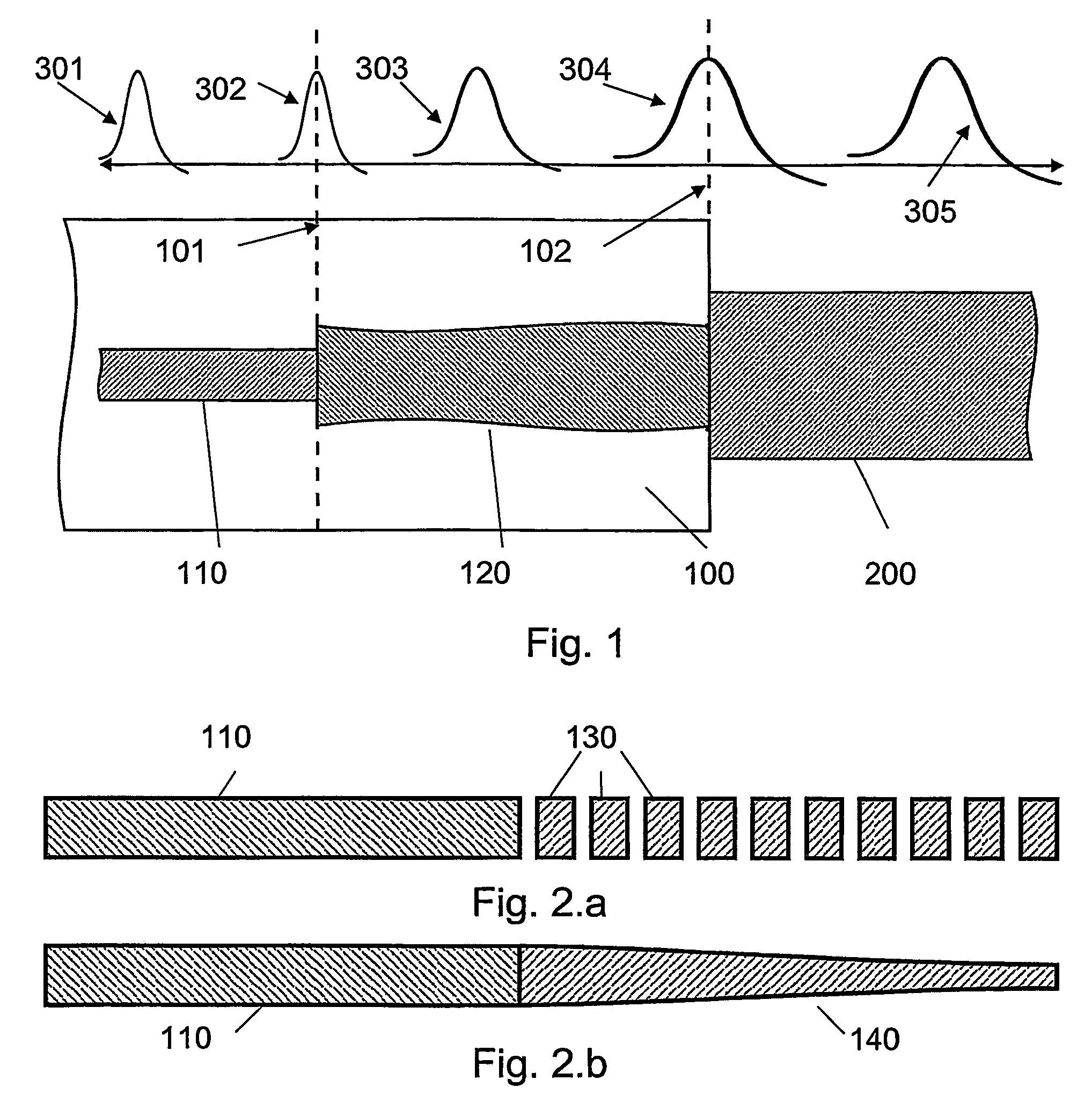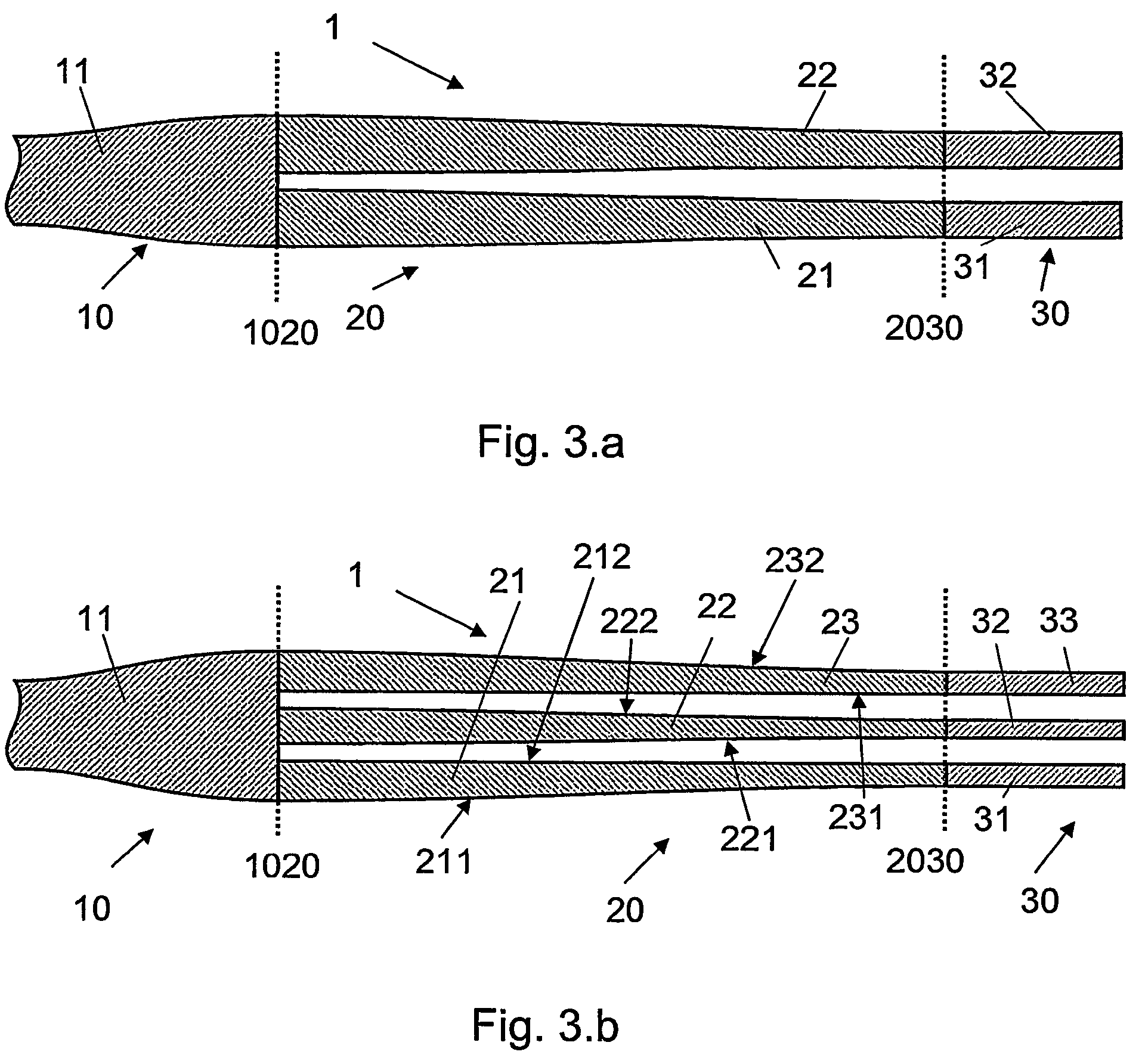Integrated optics spot size converter and manufacturing method
a technology of spot size converter and integrated optics, applied in the field of optical components, can solve the problems of difficult reproducibility of specific spot size, difficult use in actual waveguide structures, and more complicated structures, and achieve the effect of improving the coupling of components and low loss
- Summary
- Abstract
- Description
- Claims
- Application Information
AI Technical Summary
Benefits of technology
Problems solved by technology
Method used
Image
Examples
example 1
[0182]In the following, an example will be given on how to construct a specific preferred 7'th order curve, e.g. for a first optical waveguide element of a first section of a spot size converter according to the present invention (it may, of course, likewise be used for forming an edge or the edges of the at least two cooperating optical waveguide elements of a second section of the optical component in question). FIG. 11 illustrates the taper design of a waveguide element of the first section of a spot size converter according to the invention. FIG. 11a shows a waveguide element 112 of the first section having edges 1121, 1122 formed as a 7th order polynomial. As in FIG. 8, the first optical waveguide element 112 has a first end 13 adapted to be optically connected to an input waveguide and an interface 1020 adapted to be optically connected to the waveguide of the second section of the spot size converter. The upper edge 1121 is represented by a curve having a length L in the z di...
example 2
[0187]In the following an example will be given on how to construct a 7'th order waveguide taper. All considerations regarding the 7'th order taper are valid also for 5'th order tapers.
[0188]A taper is a waveguide element that changes width from a start width W1 to an end width W2 over the length L_Taper. A 7'th order waveguide taper is a taper where at least one of the sides of the waveguide is described by a 7'th order polynomial.
[0189]FIG. 11b exhibits three different 7'th order tapers, the upper (a) and lower (c) tapers having one edge linear and the other edge tapered by a 7'th order polynomial (the tapers being each other's mirror image). The middle taper (b) represents a preferred embodiment where both edges 1121, 1122 of the first section 112 of a spot size converter follow a 7'th order polynomial, thereby adiabatically transferring the fundamental mode from one width to another width. Elements 111 and 113 to the left and right of the taper 112 of the middle taper (b) are du...
example 3
[0197]This example will focus on how to fabricate a specific spot-size converter (as e.g. schematically illustrated in FIG. 3.a or FIG. 8.h). The spot-size converter consists of a taper (termed section 1 above) that transforms the fundamental mode from one width W1 to another width W2, followed by two arms (termed section 2 above) that further propagate and shape the mode such that it as far as possible resembles the mode of an output waveguide typically of different origin (e.g. an optical fibre) as compared to the one of width W1.
[0198]For the sake of simplicity said two arms are made from tapered cosines, but may also be made from adiabatic tapered 5'th or 7'th order polynomials (cf. examples 1 and 2 above).
[0199]The tapered cosine waveguide is described by the area between an upper curve U(z), and a lower curve L(z), where
[0200]U(z)=x(z)+W(z)2L(z)=x(z)-W(z)2
where x(z) is the centre line, and W(z) is the position dependent width of the waveguide taper
[0201]x(z)=H2(1-cos...
PUM
 Login to View More
Login to View More Abstract
Description
Claims
Application Information
 Login to View More
Login to View More - R&D
- Intellectual Property
- Life Sciences
- Materials
- Tech Scout
- Unparalleled Data Quality
- Higher Quality Content
- 60% Fewer Hallucinations
Browse by: Latest US Patents, China's latest patents, Technical Efficacy Thesaurus, Application Domain, Technology Topic, Popular Technical Reports.
© 2025 PatSnap. All rights reserved.Legal|Privacy policy|Modern Slavery Act Transparency Statement|Sitemap|About US| Contact US: help@patsnap.com



